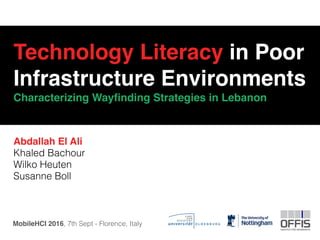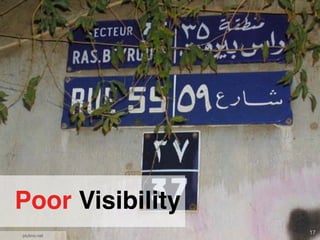MobileHCI 2016 - Technology Literacy in Poor Infrastructure Environments: Characterizing Wayfinding Strategies in Lebanon
- 1. Technology Literacy in Poor Infrastructure Environments Characterizing Way’¼ünding Strategies in Lebanon Abdallah El Ali Khaled Bachour Wilko Heuten Susanne Boll MobileHCI 2016, 7th Sept - Florence, Italy
- 2. GlobalWebIndex 2013 ŌĆ© Most globally used app in 2013 2
- 3. 3 195 countries (2016 United Nations estimate)
- 4. 4 CC BY-SA 4.0 154 are still considered developing
- 5. CC BY-SA 4.0 Such mobile navigation & mapping technology has not speci’¼ücally been designed for those 154 countries, making up 79% for our world countries 5
- 6. 6 Human Computer Interaction for Development (HCI4D)?
- 7. 7 ŌĆó Qualitative exploratory ’¼üeldwork for technology practices in infrastructure-poor settings (Ahmed et al., 2015; Wyche, 2015; Jensen et al., 2012) ŌĆó Introducing new tools in such communities (Medhi-Thies, 2015) ŌĆó Quantitatively assessing knowledge sharing in location-based social Q&A (Park et al., 2014)
- 8. 8 What about so-called ŌĆśindependent usersŌĆÖ? jeshoots.com
- 9. jeshoots.com (Oreglia et al., 2011) ŌĆó typically younger people ŌĆó can use mobile phones and/or computers without constant help from outsiders ŌĆó can learn new tasks and functions by themselves or from peers 9 What about so-called ŌĆśindependent usersŌĆÖ?
- 10. jeshoots.com Little research has paid attention to how technology literate individuals that live in a poor infrastructure environment use technology aids in general, and digital navigation aids in particular 10
- 11. 11
- 12. 12 ~ 5.8 M population ~ 1 M Syrian refugees 10,452 km2 ~ 87% live in cities ~ 75% use internet
- 20. 20 ŌĆó Geomapping Lebanon is not hard ŌĆó Crowdsourced mapping efforts are low ŌĆó People do not rely on mapping services ŌĆó People distrust mapping services ŌĆó People often rely on people Observations J.Hassoun
- 21. 21
- 22. 22
- 23. 23 What kinds of navigation and addressing problems are currently faced in Lebanon? What strategies do technology literate individuals living there employ to overcome them? 1. 2.
- 24. 24 Information access and navigation strategies for ’¼ünding unfamiliar POIs Flickr: zoghal
- 25. 25 Strategies for giving directions to an address Source: leong
- 28. 28 Part 1: Interviews Flickr: Iwan Gabovitch
- 29. 29 P1 29 yrs Software Developer 26 yrs LB P2 33 yrs Graphic Designer 12 yrs LB P3 33 yrs Assist. Prof. 8 yrs LB P6 22 yrs Graduate Student 21 yrs LB P8 27 yrs Web Designer 27 yrs LB P9 25 yrs Media Editor 25 yrs LB P12 22 yrs Exercise Instructor 22 yrs LB P4 20 yrs Undergrad Student 1 yr LB P5 22 yrs Writer / Musician 21 yrs LB P7 35 yrs HR Director 34 yrs LB P10 18 yrs Architect 18 yrs LB P11 22 yrs Teacher 22 yrs LB Part 1: 12 participants CC license: Madebyoliver
- 30. 30 1. Finding an unfamiliar POI ŌĆó before trip: information needs for ’¼ünding where an unfamiliar POI is ŌĆó during trip: information search strategies Part 1: Scenarios
- 31. 31 2. Giving route directions ŌĆó give directions to their house ŌĆó previous dif’¼üculties (if any) ŌĆó route directions they expect Part 1: Scenarios
- 33. 33 ŌĆó Homogenous sampling (forums, print outs, social networks) ŌĆó Required: a) Live in Lebanon b) Used mapping services (Google Maps) c) Used messaging (WhatsApp) ŌĆó 3 x 50$ e-gift cards Part 2: Procedure
- 34. 34 56 29 85 total >1 yr in Lebanon 17-74 years old (M = 27) 91% Lebanese Part 2: Respondents CC license: Madebyoliver 64% use maps once a week and messaging apps daily 67% own car or motorcycle 54% walk 40% take a ŌĆśserviceŌĆÖ
- 35. 35 1. Multi-faceted Information Access Strategies Wikipedia: Tony Webster
- 36. 36 Search in digital maps (e.g., Google, Bing, Apple)68% Before the Trip 38% Web search query (e.g., Google) 39% Go to website of the place 40% Call a friend or family member 44% Find out if there are popular landmarks nearby
- 37. 37 IŌĆÖd start by asking my friends, and then IŌĆÖd google map it. [if not on google maps?] Then IŌĆÖd google its name and check online if thereŌĆÖs an indication of what the address is. ŌĆØ ŌĆ£
- 38. 38 Use digital maps (Google / Bing / Apple Maps)66% During the Trip 21% Make use of street signs 40% Get in taxi / service and rely on driver to know address 65% Get to general area and ask people there
- 39. 39 I would ask the people around me on the street. I keep asking until I ’¼ünd out, someone must know. ŌĆØ ŌĆ£
- 41. 41 Outdated information on the map54% Problems with Digital Maps 66% Incorrect position marker on map 53% Incorrect / missing places on map 39% Incorrect route plan
- 42. 42 Maps [Google Maps] are not very well populated with information, and then it turns into basic map reading, and not just on the go. ŌĆØ ŌĆ£
- 43. 43 When asked whether they experienced problems when using mapping services before, respondent responses were divided (Md = 4, IQR = 3-5)
- 44. 44 Respondents' reported experienced dif’¼üculties with mapping services and whether they used mapping services once a week or several times a week was signi’¼ücant (p < 0.01, FET13)
- 45. 45 3. Multi-faceted Direction Giving Strategies theredlist.com
- 46. 46 Pin [Google Maps] accompanied by general description. So you get to the general area, pin will get you there. There will be a blue building, and right behind it is a blue dumpster, and if you see, you can actually pass through there. So yes, I feel itŌĆÖs a combination of pin plus directions, thatŌĆÖs the way to go in this countryŌĆ” ŌĆØ ŌĆ£
- 47. 47 When this happened, I made a drawing. Exactly because itŌĆÖs easier to know the main roads, and direction of the streetsŌĆ” ŌĆØ ŌĆ£
- 48. 48 facebook.com
- 49. 49 When asked whether they previously experienced problems when giving directions to their home to a person that has not visited before, respondent responses were again divided (Md = 4, IQR = 3-5)
- 50. 50 No signi’¼ücant effect between living in a well known area and faced dif’¼üculties when giving directions (ØÆ│┬▓ = 4.75, p = 0.09)
- 51. 51 No real dif’¼üculties, got used to it You get used to it For someone new to the country, I think it is very very dif’¼ücult to adapt to our system. But IŌĆÖve got the hang of it ŌĆØ ŌĆ£ ŌĆØ ŌĆØ ŌĆ£ ŌĆ£
- 52. 52 ŌĆ½┘ģž¦┘ģž▒ŌĆ¼ ŌĆ½┘ģ┘üž▒ž¦ŌĆ¼ ŌĆ½┘ģ┘üž▒ž¦žĪŌĆ¼ ŌĆ½ž┤ž¦ž▒ž╣ŌĆ¼ŌĆ½ž▓ž¦ž▒┘łž©┘ŖŌĆ¼ rue ruelle route alleyway road street 4. Language Ambiguity, Conventions, and Technology
- 53. 53 Street labels on map do not correspond to how people talk about them 27%
- 54. 54 There is confusion. For example my street, my old street near Barbar [restaurant], they changed the name at one point, but no one knows, so they refer to it as Leon, sometimes Emile Eddie, others something different. So uhh, itŌĆÖs referred to mostly as Leon, but thatŌĆÖs not whatŌĆÖs put on the sign. Because they changed it and they donŌĆÖt amend the systemŌĆ” ŌĆØ ŌĆ£
- 55. 55
- 56. 56 5. Tech Literacy & Expectations Wikipedia: RudolfSimon
- 57. 57 Yes, some people donŌĆÖt know how to use Google Maps or the WhatsApp thing, so I would have to tell them by mouth, by words, and sometimes they donŌĆÖt get it, so IŌĆÖd have to go get them from there [the place they are currently at]. ŌĆØ ŌĆ£
- 59. 59 Then this wouldnŌĆÖt work obviously, youŌĆÖd have to go stand there. You would have to give a street name, a written address kind of thing. ŌĆØ ŌĆ£
- 60. 60 Cultural and environmental assimilation vs. Range of strategies to overcome such way’¼ünding dif’¼üculties Role of Culture? milinme.wordpress.com
- 61. 61 Way’¼ünding Problems - Unique? * Language & Cultural Issues M.C. Escher
- 62. 62 Social Querying + Tech Aids Wikipedia: The National Archives
- 64. 64 Local Knowledge Credit: Richard Hall
- 65. 65 So What? Conventions are important!
- 66. 66 ŌĆó Mix social querying with technology aids ŌĆó Draw more on landmark-based navigation ŌĆó Utilize local knowledge, especially for language issues Full paper: http://dl.acm.org/citation.cfm?id=2935352 Thank you Abdallah El Ali www.abdoelali.com abdallah.el.ali@uol.de @abdoelali Take-home
- 67. 67 Syed Ishtiaque Ahmed, Nusrat Jahan Mim, and Steven J. Jackson. 2015. Residual Mobilities: Infrastructural Displacement and Post-Colonial Computing in Bangladesh. In Proc. CHI ŌĆÖ15. ACM, New York, NY, USA, 437ŌĆō446. ŌĆ© GlobalWebIndex. 2013. (2013). http://www.globalwebindex.net/blog/ top- global- smartphone- apps ŌĆ© Kasper L. Jensen, Heike Winschiers-Theophilus, and Kasper Rodil. 2012. Tapping into Local Lore: Toward Scalable Local Mapping and Tagging for Rural Africa Using Mobile Devices. In Proc. NordiCHI ŌĆÖ12. ACM, New York, NY, USA, 631ŌĆō634. Indrani Medhi-Thies, Pedro Ferreira, Nakull Gupta, Jacki OŌĆÖNeill, and Edward Cutrell. 2015. KrishiPustak: A Social Networking System for Low-Literate Farmers. In Proc. CSCW ŌĆÖ15. ACM, New York, NY, USA, 1670ŌĆō1681. Sangkeun Park, Yongsung Kim, Uichin Lee, and Mark Ackerman. 2014. Understanding Localness of Knowledge Sharing: A Study of Naver KiN ŌĆÖHereŌĆÖ. In Proc. MobileHCI ŌĆÖ14. ACM, New York, NY, USA, 13ŌĆō22. Wikipedia. https://en.wikipedia.org/wiki/Lebanon Susan Wyche. 2015. Exploring Mobile Phone and Social Media Use in a Nairobi Slum: A Case for Alternative Approaches to Design in ICTD. In Proc. ICTD ŌĆÖ15. ACM, New York, NY, USA, Article 12, 8 pages. References





































![37
IŌĆÖd start by asking my friends, and then IŌĆÖd
google map it. [if not on google maps?] Then
IŌĆÖd google its name and check online if thereŌĆÖs
an indication of what the address is.
ŌĆØ
ŌĆ£](https://image.slidesharecdn.com/mobilehci2016presv3-160908130422/85/MobileHCI-2016-Technology-Literacy-in-Poor-Infrastructure-Environments-Characterizing-Wayfinding-Strategies-in-Lebanon-37-320.jpg)




![42
Maps [Google Maps] are not very well
populated with information, and then it turns
into basic map reading, and not just on the go.
ŌĆØ
ŌĆ£](https://image.slidesharecdn.com/mobilehci2016presv3-160908130422/85/MobileHCI-2016-Technology-Literacy-in-Poor-Infrastructure-Environments-Characterizing-Wayfinding-Strategies-in-Lebanon-42-320.jpg)



![46
Pin [Google Maps] accompanied by general
description. So you get to the general area,
pin will get you there. There will be a blue
building, and right behind it is a blue
dumpster, and if you see, you can actually
pass through there. So yes, I feel itŌĆÖs a
combination of pin plus directions, thatŌĆÖs the
way to go in this countryŌĆ”
ŌĆØ
ŌĆ£](https://image.slidesharecdn.com/mobilehci2016presv3-160908130422/85/MobileHCI-2016-Technology-Literacy-in-Poor-Infrastructure-Environments-Characterizing-Wayfinding-Strategies-in-Lebanon-46-320.jpg)







![54
There is confusion. For example my street, my
old street near Barbar [restaurant], they
changed the name at one point, but no one
knows, so they refer to it as Leon, sometimes
Emile Eddie, others something different. So
uhh, itŌĆÖs referred to mostly as Leon, but thatŌĆÖs
not whatŌĆÖs put on the sign. Because they
changed it and they donŌĆÖt amend the
systemŌĆ”
ŌĆØ
ŌĆ£](https://image.slidesharecdn.com/mobilehci2016presv3-160908130422/85/MobileHCI-2016-Technology-Literacy-in-Poor-Infrastructure-Environments-Characterizing-Wayfinding-Strategies-in-Lebanon-54-320.jpg)


![57
Yes, some people donŌĆÖt know how to use
Google Maps or the WhatsApp thing, so I
would have to tell them by mouth, by words,
and sometimes they donŌĆÖt get it, so IŌĆÖd have to
go get them from there [the place they are
currently at].
ŌĆØ
ŌĆ£](https://image.slidesharecdn.com/mobilehci2016presv3-160908130422/85/MobileHCI-2016-Technology-Literacy-in-Poor-Infrastructure-Environments-Characterizing-Wayfinding-Strategies-in-Lebanon-57-320.jpg)









